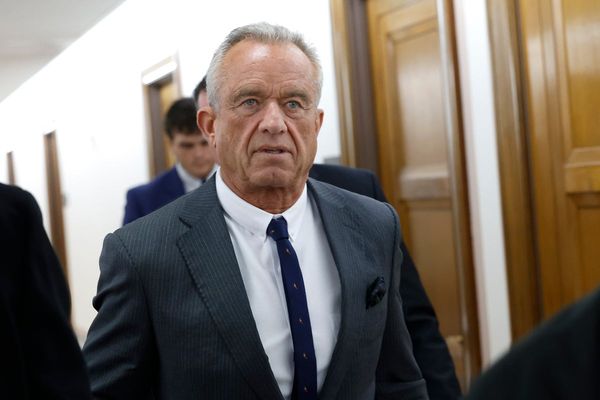
CHARKINT, Afghanistan—On the gold and green plains of northern Afghanistan’s Balkh province, the days seem peaceful; the nights are anything but. Once darkness falls, armed gunmen speed out of Taliban-occupied villages like motorcycle gangs on the rampage, charging checkpoints manned by citizen militias intent on protecting themselves from an insurgent onslaught.
Firefights can last a few hours or all night. “Their aim is to keep us up, keep us vigilant, and to exhaust us,” said Mohammad Amir, the head of the Uprising Commission in Charkint district, an hour’s drive south of the provincial capital, Mazar-i-Sharif. That makes him the head of logistics for about 350 local men who have taken it upon themselves to stop the Taliban’s advance across their corner of Afghanistan.
At their head is Salima Mazari, a 40-year-old district governor and one of the few women to have ever reached this position in Afghanistan’s male-dominated political landscape. She said that for the three-and-half-years she has been in the post, 80 percent of her time has been spent fighting the war as the Taliban attempt to drive out the 32,000 Hazara and Uzbek people who live here.
She also got a road built, a huge achievement in this impoverished corner of one of the world’s poorest countries. The insurgents persistently try to block it, she said, and some stretches have been mined.

As the sun begins to set and the heat goes out of the days, Mazari tours the front lines, her armored car often blasting a martial anthem to inspire the people she serves.
She climbs steep hills to talk to men who will spend their nights in foxholes or flimsy tents on ridges overlooking Taliban positions. She makes sure they have enough food, ammunition, and support from the Afghan National Army, the police, and the National Directorate of Security. The latter is Afghanistan’s secret service, which is funding and arming militias across the country.
Her leadership skills and the respect she commands are obvious. She spends her days meeting with local commanders and fighters who visit her threadbare office for updates. One local National Directorate of Security representative tells her he cannot explain the recent disappearance of 40,000 bullets meant for her men. She berates a World Food Program employee for providing flour to the Taliban-occupied villages. Her phone never stops buzzing.
The Taliban have been fighting hard across northern Afghanistan for the past few weeks, seizing territory from Afghanistan’s security forces. The insurgents have hoisted their flag above dozens of villages and districts, stormed border posts that provide a huge opportunity for illicit income, and hit hard at local and national morale. Some victories have been reversed as control ping-pongs between the insurgents and the republic.
Their strategy is clearly to exhaust the Afghan forces into giving up the fight—and they have with alarming regularity. This infects the general population as people across the country fear that with the departure of U.S. and international forces—as soon as this month—their military will be unable to prevent a Taliban takeover.
The government of Afghan President Ashraf Ghani, lacking a coherent strategy of its own, has welcomed the emergence of this so-called uprising—essentially, ordinary people taking up arms to fight off the Taliban. But it comes with risks. Some senior officials in the security sector fear the armed groups will become the personal armies of local political figures seeking to bolster their power. Others have described them “human shields” protecting an embattled military that is rapidly losing its will to fight.


“Arming people is harmful for Afghanistan in the short term and the long term,” Shukria Barakzai, a diplomat and former member of parliament, told Radio Free Europe/Radio Liberty. “First, it will add to the presence of illegal armed forces, and second, it will add to the conflicts that already exist between local commanders and different ethnic groups, which means it will worsen insecurity.”
Indeed, in many places Afghanistan’s war looks like an ethnic conflict, with Hazaras, Uzbeks, and Tajiks taking up arms to repel what they see as a Pashtun nationalist movement, using the banner of the Taliban and the cloak of religion to seize their land and assets.
“It’s about power,” said Mazari, the Charkint district governor. She said Pashtun incursions over the past four decades had caused the population of Charkint to fall by nearly 80 percent. Elsewhere in Balkh, the Uzbek and Tajik communities are also organizing militias to fight the Taliban offensive.
Enayat Najafizada, co-founder and CEO of the Institute of War and Peace Studies, a Kabul-based think tank, said the militias needed to be well managed by the government to prevent them from becoming tools of local political and ethnic interests.
“If history is any guide, the moment these forces defeat the Taliban, they would most likely confront each other over political, military, and resources interests, given that they are already divided along ethnic lines,” he told Foreign Policy. “If not well managed, we could see serious disputes at the local level, which would provide a platform for further chaos and anarchy.”
The White House provided a boost to the Afghan government last week when Biden met with Ghani and promised financial and logistical support to Afghan forces. Media reports also said the contracts of Americans keeping the Afghan Air Force functioning will be extended at least through September, giving relief to people like Mazari who say close air support is the only real edge Afghan forces have against the insurgency.
The Afghan Air Force’s Super Tucano attack aircraft were recently deployed in Charkint against Taliban positions, she said, and they can be heard throughout the day and night, roaring above the clouds.
Mazari said the fighting began in earnest last August, after people started complaining to her that Taliban operatives were turning up at villages and demanding a “religious tax.” “They were taking their sheep and their grain, so that they would have supplies to get them through the winter,” Mazari said.
She complained to the police. “They told me it was none of my business, and then people started asking me what we had a government for. So I ordered the police and security forces to get out there and tell the Taliban to stop taxing the people. That’s when the war really started,” she said.
It has escalated dramatically since May 1, the date former U.S. President Donald Trump pledged to withdraw all American forces by—extended by President Joe Biden to Sept. 11.

The Taliban’s tactics can be seen clearly in Charkint, where Mazari believes she is indeed fighting an ethnic war against a nationalist Pashtun movement intent on driving other ethnicities off their land. “They don’t offer anything when they come,” she said of the Taliban. In Tandurak village, not far from the Charkint district center where Mazari and her husband, Ali Ahmad, work and live, the Taliban fought hard, took control, and then mined the bodies of people who had died fighting to defend it, she said.
“These are ordinary people, farmers, teachers, businesspeople. When their families came to get them from the battlefield, their bodies had been booby-trapped. There are mines on the roads leading into and out of the village. This is all they offer, nothing else,” she said.
On one recent evening as she, Ahmad, and a couple of guests finished a meal of boiled liver and fried onions, she took a call warning her that about 100 motorbikes had gathered in Tandurak village, and at least 15 gunmen were heading on foot toward her, sparking fears that a major attack was imminent. “We have to go, quietly and calmly so no one suspects anything,” she said.
She picked up her handbag, and in her rubber-soled sandals and long grey-and-white polka-dot dress, headed out to meet a handful of loyal gunmen who escorted her across rocky paths through the wheat fields, their way illuminated only by starlight.

Throughout the one-hour hike to safe houses, the sound of automatic and heavy gunfire got closer. The Taliban were on her trail, she thought. Once settled at the second safe house deep inside another village, called Shar Shar, a militia lookout came to explain what had happened. It was the same scene that had unfolded two nights earlier.
Taliban gunmen on motorbikes fanned out from Tandurak, hit checkpoints—some of which had been abandoned by a militia under the control of a political rival of Mazari’s—and sped toward the district center. When Mazari returned to her office early the next morning, Amir, the uprising logistician, was there waiting to report. The firefight continued for a few hours, until the Taliban were repelled, he said.
Mazari is a rare figure in Afghanistan—a woman, a Hazara, and a Shiite in a country dominated by Sunni, Pashtun men. She has no faith in Ghani’s government and said she has received no support from either the provincial authorities in Mazar-i-Sharif or from Kabul. Her office, which is also her home, has no electricity or running water. The curtains are torn and worn, lighting is rigged up to a single solar battery, the toilet is a hole in the ground, and the kitchen is a pot over a flame provided by a gas bottle.
For an official car, she said, she was given an old ambulance. “I drove it to Kabul and asked why, if other district governors have armored cars, I didn’t. So they gave me one,” she said.
Yet the people of Charkint rally around her leadership, admiring her unswerving support and bravery, welcoming her on hilltops and in the ramshackle bazaar, waving back as she drives to the remains of the house of a distant relative, Abdul Ali Mazari.
Little is left of his home in the lee of mountains that, according to local lore, contain the remains of ancient civilizations. Abdul Ali Mazari was an advocate of federalism that would give Afghanistan’s main ethnic groups constitutional protection. He was tortured and killed by the Taliban in 1995.
As she pays homage, Salima Mazari wonders aloud how long her local militia can hold out against the Taliban. “They are supported by local people, who give food, give their time to cook for the fighters, give what they can. But they have to work, too, they have to support themselves, they have to bring in the wheat and the chickpeas. How long can we expect them to continue their sacrifice, when they get so little in return?”







